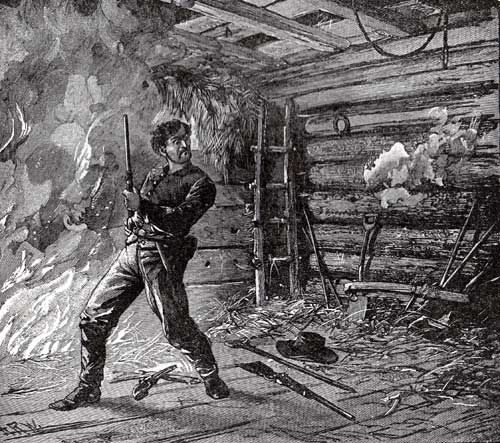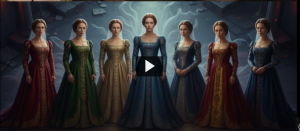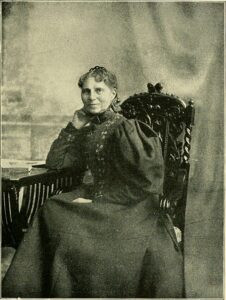After the deadly acts were committed, John Wilkes Booth spurred his horse, and rode furiously into the night. His intentions were to meet up with with David Herold and head towards the Southern sympathizers in Virginia. As Booth rode in the night, Lewis Powell panicked and could not find a way to escape from Washington. Instead of trying to make his way out, Powell stayed in the city and rode around, lost in the labyrinth that were the streets of Washington, D.C.1 Booth met up with Herold and made his way to the Surratt Tavern. The two men hopped off their horses and entered the tavern, and it was here that they gathered a carbine rifle and some ammunition, and began to plan their next move.2 Booth, still hurt from his fall onto the stage, persuaded Herold to take a slight detour to visit a doctor to fix his leg.

Booth and Herold rode their horses for about four hours from the Surratt Tavern towards the house of Dr. Samuel Mudd. The pair reached the house at around four in the morning, and woke up Dr. Mudd.2 By that time, the news of the assassination had not yet reached Dr. Mudd, so he bought the story that Booth told him, quickly splinted his leg, and offered to house the two for a couple of hours. In the afternoon, after a trip into town, Dr. Mudd discovered that there was a manhunt for Booth and upon arriving back home, demanded that the two leave, and they did.4
The duo roamed aimlessly through the woods, until they wandered onto a ranch owned by Samuel Cox, a Southern sympathizer.5 Booth revealed his identity to him, and discussed the assassination with the man, and Cox agreed to let him stay until his foster brother, Thomas Jones, arrived and would help him cross the Potomac River to reach Virginia, where Booth believed he would be welcomed as a hero.6 Once Jones arrived, Booth demand a newspaper to see what the country thought of his actions. Booth believed that he would be thought of as a national a hero, but instead, the country was infuriated. The newspapers called him a coward and a common cut throat.7 All hopes of being the country’s savior was destroyed, and Booth began to write his final words in his diary.
After Jones led the men across the Potomac, Booth and Herold continued south finding different places to hide from the authorities, until finally they reached the farm of one Richard Garrett in Bowling Green, Virginia.8 It was here the two believed that they would be safe. The Garrett family offered a place in their barn for the two to sleep, and the duo accepted it graciously.9
While Booth and Herold were settling in, Lieutenant Edward Baker was hot on the trail of the assassins and found information that led him and his fifty troops to the Garrett Farm. Within a couple of hours, Lt. Baker arrived at the Garrett Farm and commanded his troops to surround the barn.10 Baker attempted to have Booth surrender, but Booth would not budge. After an hour of dialogue, Herold ran out of the barn with hopes of surrendering. As soon as he was out of the barn, he was arrested and tied to a tree. As more time passed, Baker became impatient. With no intention to kill Booth, Baker set the barn on fire in an attempt to flush him out.11
Booth seeing how fast the fire was spreading ran with his crutches and his carbine in hand to try and put out the fire. While attempting to fight the fire, Sergeant Boston Corbett, a solider that surrounded the barn, took aim and shot Booth right through the neck.12 The soldiers scrambled inside to retrieve his body and while they did Booth began to whisper, “Tell my mother I died for my country,” and begged the soldiers to kill him so he may not suffer. The soldiers attempted to save his life but Booth died that morning.13

Booth, now dead, could not stand trial for Lincoln’s assassination, but the others could. In May of 1865, George Atzerodt, Lewis Powell, David Herold, Dr. Samuel Mudd, and Mary Surratt (Owner of the Surratt Boarding House) were pressed with charges of conspiring to assassinate the President of the United States. After only a month of trial, the jury found Atzerodt, Powell, Herold, and Surratt guilty, and they were sentenced to hang on July 7th, 1865.14 Mudd was sentenced to life in prison, but was pardoned by President Johnson in March of 1868.

The quartet of conspirators were lead to the scaffold and the whole time the team was calm. At a point during the execution Powell exclaimed to the crowd that Mary Surratt was innocent; nevertheless, the group was hung. Mary Surratt was later found not guilty due to the fact there was no physical proof that cited she knew what was happening in her building. Her execution was seen as a major mistake made by the United States Government.15
The purpose behind the assassination of President Lincoln was to have him erased from the memory of history. Booth hoped that after he was dead the country would be saved and that he would be praised by all. Lincoln, in his time, had mixed reviews from the citizens, but after his assassination he ascended into martyrdom, and is now one of the most recognized Presidents of all time.16 Booth, however, is now cast aside and is seen as the equivalent to Brutus, an insane assassin.
- Arthur F. Loux, John Wilkes Booth : Day-by-Day (Jefferson, N.C.: McFarland & Company, Inc., Publishers, 2014), 211. ↵
- Loux, John Wilkes Booth: Day-by-Day, 212. ↵
- Loux, John Wilkes Booth: Day-by-Day, 212. ↵
- Kathy Wilmore, “Wanted! The President’s Killer,” Junior Scholastic 117, no. 12 (April 20, 2015): 12. ↵
- Loux, John Wilkes Booth: Day-by-Day, 213. ↵
- Loux, John Wilkes Booth: Day-by-Day, 214. ↵
- Wilmore, “Wanted! The President’s Killer,” Junior Scholastic 117, no. 12 (April 20, 2015): 13. ↵
- Salem Press Biographical Encyclopedia, January 2006, s.v “John Wilkes Booth.” ↵
- Wilmore, “Wanted! The President’s Killer,” Junior Scholastic 117, no. 12 (April 20, 2015): 13. ↵
- Wilmore, “Wanted! The President’s Killer,” Junior Scholastic 117, no. 12 (April 20, 2015): 13. ↵
- Loux, John Wilkes Booth: Day-by-Day, 220. ↵
- Loux, John Wilkes Booth: Day-by-Day, 221. ↵
- Loux, John Wilkes Booth: Day-by-Day, 221. ↵
- Wilmore, “Wanted! The President’s Killer,” Junior Scholastic 117, no. 12 (April 20, 2015): 13. ↵
- Rosanna Ledbetter, “Mary Surratt,” American National Biography (from Oxford University Press): 2010. ↵
- Salem Press Biographical Encyclopedia, January 2006, s.v. “John Wilkes Booth”, by R. Baird Shuman. ↵



27 comments
Edgar Velazquez Reynald
This is a great conclusion to your first piece on the Assassination. What happened to Booth’s coconspirators pays off because you mentioned what their assigned duties were for the night in Part I. I do agree with Danielle that Mary Surrat should have been given a bit more of context and exposition because her hanging is such a crucial part of the climax of your piece. Overall it’s a great piece. Thank you.
Sara Ramirez
I enjoyed both parts of your article. In the first one you gave the audience exposition and established the rising action with a climactic ending that made the reader want to continue. In this part of the story, I think you did a good job establishing the resolution and expanding on the outcomes of each of the major characters. This article helped to decipher the twisted motivations of Booth and the infamous legacy he created for himself. Very well written article!
Danielle A. Garza
I truly enjoyed both parts of your article. There was a great deal that I learned, and I love your storytelling technique. I will use it In my own articles and I greatly appreciate it. I would have liked it if you would expand on the Murrat story a bit more. She is placed at the end of the article in a short paragraph where I feel like this could be a part 3 of the story.
Mario Sosa
Interestingly enough, I read somewhere that Lincoln established the Secret Service only hours before his assassination. If I remember right, they were originally created to fight against the spread of counterfeit money. I appreciate that you acknowledged the other planned simultaneous attacks in part 1 regarding Andrew Johnson and William H. Seward as it is not something that not many people were aware of. Once again, good work.
Raymond Munoz
This isn’t the first two part article I have read on StMU History Media and at first I was kind of avoiding them because I thought they would be boring stretched out story’s. Though, in actuality I believe that the two part articles are the best, because they have the opportunity to explore more in depth details that single articles can’t. I believe the author did an outstanding job in both articles and kept me interested with minor details that I had never known before.
Roman Olivera
Well, this article answered the questions I had after the first article. I wanted to know what happened to the people involved with helping the assassins gain access to President Lincoln. The people that assisted definitely got what they deserved, except Mary Surratt. Its sad that she was falsely accused of assisting them and executed. It seemed like America just wanted justice and with John Wilkes Booth death, the wanted to show harsh punishment on those they seen responsible for aid these vigilantes. Unfortunately it was guilt by association. Both parts of the article where well written. Very informative writing about a subject I thought I new about and found out even more by the readings.
Natalia Flores
That’s sad that Mary Surat had been pardoned after she had been hanged. I didn’t know that Booth had to be flushed out via setting fire to the barn he was in and why did he think that people would think of him as a hero? If anything, it would be seen as frightening since he publicly executed someone. I find it shocking that they arrested Dr. Mudd as well even though he didn’t know anything.
Mario Sosa
For so much time being spent planning out the assassination, you would think that Booth would have come up with a better escape plan. I am actually curious as to what Booth wrote down in his diary, as this was right after he found out that the public saw him as a criminal and Lincoln a martyr. Also, assuming that she truly had nothing to do with the assassination, it was unfortunate that Mary Surratt was killed for conspiracy. Nicely done article, very entertaining!
Zaraly Frasquillo
Man, I should have read Part I first, but I did not. Alright let me start by saying Robert, you are my favorite writer! You legit know how to keep someone wanting to read more and more! As I was reading your amazing article I could actually SEE it, which only a couple of writers can do. You are as awesome as Boothe!
Sam Vandenbrink
The article is very well phrased and the author makes good specific references. Sometimes people don’t take into consideration the harsh past that the United States has had, people look it over thinking the United States some heaven. The author does an excellent job relaying a rather long story in a short period of time. He supplies the reader with good little facts and keys to piece the story together in ones head.